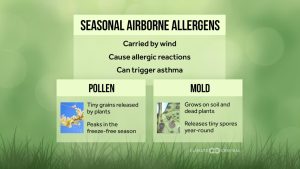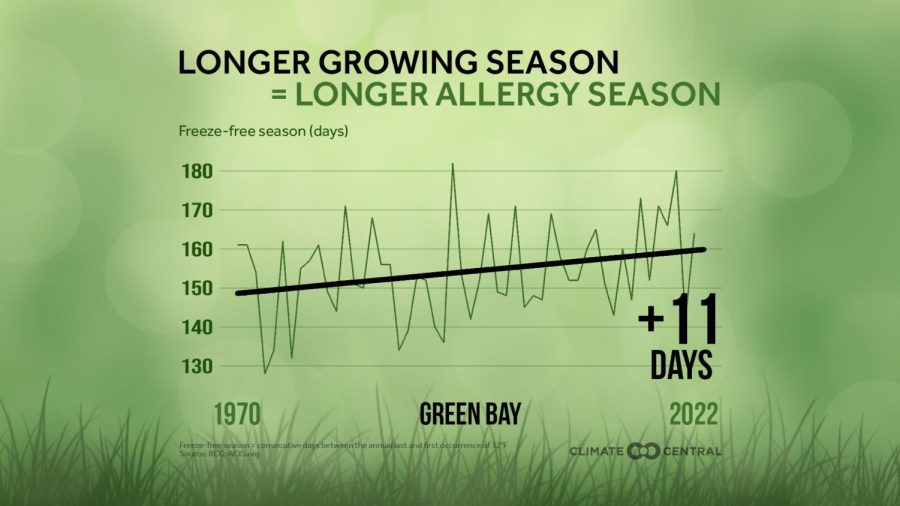Climate change lengthens allergy season
Climate Central – Growing season has lengthened by 11 days in Green Bay since 1970, resulting in a longer allergy season.
April 5, 2023
A recent study found that the freeze-free season is lengthening across the United States, which is bad news for those who suffer from seasonal allergies.
The freeze-free/growing season is the time between the last freeze of spring (a temperature below 32 degrees Fahrenheit) and the first freeze of fall. During this time, plants can grow and reproduce, which involves the production of pollen, a common allergen.
In a study by Climate Central, a nonprofit news organization that analyzes and reports on climate science, researchers analyzed the length of freeze-free seasons in 203 cities across the country from 1970 to the present.
The researchers determined that the freeze-free season lengthened in 85% of the cities studied, with an average increase of 15 additional growing days.
This is undoubtedly due to climate change and greenhouse gas emissions, which are causing the warming of the globe, shifts in seasonal patterns and increased carbon dioxide in the atmosphere.
The lengthening of the growing season is an unwelcome trend for the millions of Americans who will have to deal with the bothersome and debilitating symptoms of seasonal allergies each year.

According to the American College of Allergy, Asthma and Immunology, seasonal allergies and non-seasonal allergies such as dust or pet dander develop when the body’s immune system misclassifies something harmless in the environment as a threat and mounts an immune response.
This immune response can be felt through symptoms such as a runny nose, itchy eyes, sneezing and more, which often have a negative effect on the daily lives of allergy sufferers.
Seasonal allergies are quite common, with the Centers for Disease Control and Prevention reporting that more than 25% of Americans had a seasonal allergy in 2021.
Dr. Anita Gheller-Rigoni, an allergist-immunologist at Aurora Medical Center in Oshkosh, says that these millions of allergy sufferers will soon start to notice their symptoms reemerge this spring as the temperature increases.
“This time of the year usually isn’t as bad, but … when the snow starts melting, that’s when more people will start coming in with their seasonal allergy symptoms,” Gheller-Rigoni said.
Plant growth is sensitive to temperature changes, so those with seasonal allergies may notice their symptoms arise on warmer days when more pollen is being produced, especially in spring when the temperature changes drastically from day to day.
“When there’s fluctuation in temperature, like right now when it gets warm and then cold and then warm and then cold, that will affect people,” Gheller-Rigoni said.
Of course, this also means that the lengthening of the freeze-free season, which comes with an earlier start to spring, is bringing more of these warm, high-pollen days earlier than usual.
Ragweed, a common perpetrator of seasonal allergies both across the country and locally, is just one example of how the changing climate is affecting plants and their releases of pollen.
“Ragweed, which would always pollinate the second week of August, now starts pollinating around the last week of July/first week of August,” Gheller-Rigoni said. “That doesn’t seem like a big deal; it’s one to two weeks. But that’s kind of a big deal because when the plants start to pollinate is usually pretty predictable, and ragweed is usually very predictable.”
But not all is doom and gloom. While this trend will certainly be a nuisance for allergy sufferers across the country, there are still many ways for them to manage their bothersome symptoms.
Gheller-Rigoni identifies three main categories of strategies that can be used to treat and prevent allergic symptoms: environmental, medicinal and long-term immune system changes.
The first way is through environmental changes, which people can do by making shifts to their environment and their behavior.
“Don’t hang clothing outside, keep your central air on and stay inside when it’s peak pollen times,” Gheller-Rigoni said, although she noted that she never recommends avoiding the outdoors as the only allergy treatment when other treatments are available.
The next and most common method for addressing seasonal allergies is using medicines that reduce the symptoms of pollen exposure.
“There’s a lot of over-the-counter medications that can be used very safely, like nasal sprays, antihistamines and eye drops,” Gheller-Rigoni said. “All three of these work if taken regularly. It’s better if you have a pollen allergy to take medication daily throughout the season, not to take it when symptoms are really bad.”
Finally, a more long-term solution is an allergy shot, which is available for most allergies including pollen.
“These (shots) involve getting tested for what you’re allergic to and then getting the allergy shot for those things; that’s more of a permanent fix, so it changes your immune system,” Gheller-Rigoni said.














